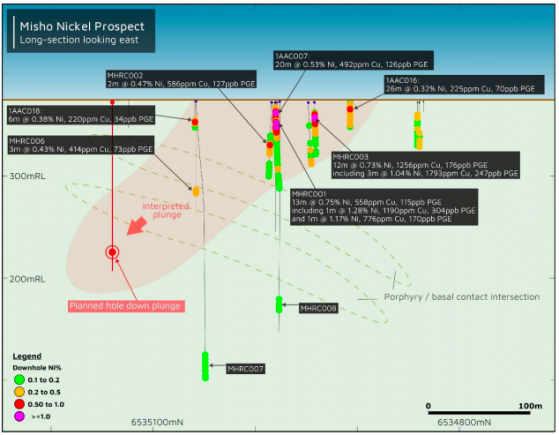Maximus Resources Ltd (ASX:MXR) has intercepted up to 1.3% nickel during drilling at the Misho prospect, confirming the presence of a fertile nickel sulphide-bearing komatiite channel near the Kambalda district in Western Australia.
Eight reverse circulation (RC) holes were recently completed to test for sulphide mineralisation, with four shallow holes intersecting visible disseminated sulphides of pyrrhotite and pentlandite with concentrations ranging from 1-5%.
The completed RC drill program has revealed a potential northerly plunge of the mineralised channel.
Long-section looking east with completed aircore and RC drill holes and planned drilling at Misho Prospect.
Assay results include the following highlights:
- MHRC001: 13 metres at 0.75% nickel, 558 parts per million (ppm) coppoer, 115 parts per billion (ppb) plantium group elements (PGE) from 22 metres, including 1 metre at 1.28% nickel, 1,190 ppm copper, 304 ppb PGE from 23 metres and 1 metres at 1.17% nickel, 776 ppm copper, 170 ppb PGE from 28 metres;
- MHRC003: 12 metres at 0.73% nickel, 1,256 ppm copper, 176 ppb PGE from 13 metres, including 3 metres at 1.04% nickel, 1,793 ppm copper, 247 ppb PGE from 16 metres;
- MHRC002: 2 metres at 0.47% nickel, 586 ppm copper, 127 ppb PGE from 47 metres; and
- MHRC006: 3 metres at 0.43% nickel, 414 ppm copper, 73 ppb PGE from 101 metres.
Maximus managing director Tim Wither said: “The initial RC program at Misho was designed around elevated nickel, copper, and PGE aircore drill intersections (to) build our geological understanding at Misho.
“Encouragingly, the RC program has intersected several shallow occurrences of disseminated pyrrhotite and pentlandite sulphide minerals within broader mineralised zones, confirming a fertile nickel sulphide-bearing komatiite channel at Misho.
“The initial RC drill program focused on the apex of the known magnetic flexure, which is interpreted to be the bottom of the komatiite channel. Based on our RC drill results and downhole electromagnetic (DHEM) survey, a shallower northerly plunge setting needs to be investigated in a follow-up drill program.
“Due to the presence of a strong sedimentary conductor about 200 metres east of the target area, the DHEM did not identify any possible off-hole nickel sulphides.
“There is still a strong chance of massive sulphide discovery, since conventional geophysics cannot identify the known mineralised intersections.
“We are still in the early stages of our exploration journey at Misho, the presence of shallow disseminated sulphide nickel, copper and PGE mineralisation is a positive indicator for potential massive nickel sulphide accumulations nearby.”
Upcoming workplan
Maximus will conduct a follow-up RC drill program later this month to investigate the continuity of the north-plunging komatiite channel.
The program will include nickel targets identified through a recent aircore drilling campaign, which yielded several significant intersections, including 20 metres at 0.53% nickel, 492 ppm copper and 126 ppb PGE from 10 metres.
It will also include structural gold targets recently identified at the Wattle Dam and Redback gold deposits.
Read more on Proactive Investors AU
